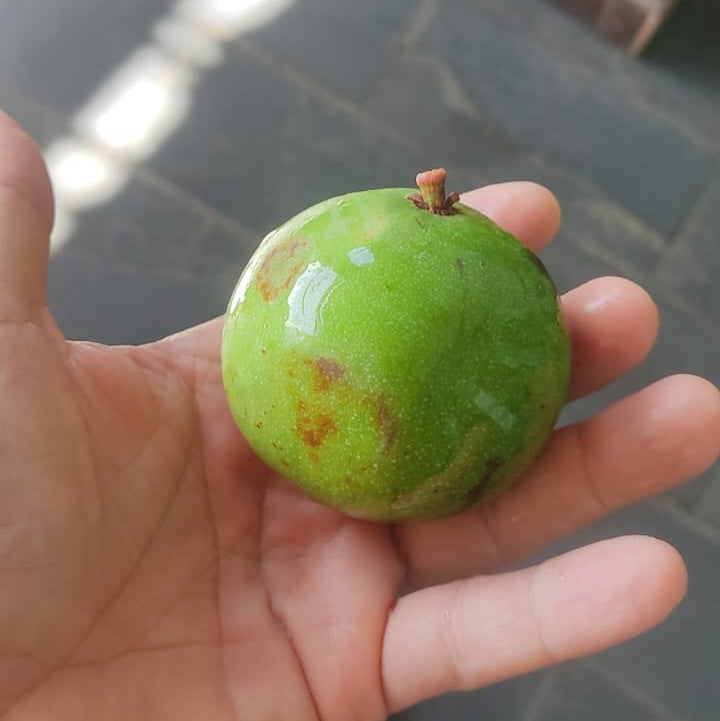Love it? Add to your wishlist
Your favorites, all in one place. Shop quickly and easily with the wishlist feature!
[message]
[title]
[message]


Veliyath Gardens
Couldn't load pickup availability
Common Name: Bahia Garcinia
Botanical Name: Garcinia bahiensis
Tucked away along the Atlantic shoreline of Bahia in Brazil, the Garcinia bahiensis thrives in quiet forest zones where nature still hums in balance. This rarely encountered species is attracting attention not just for its edible and luscious green fruits but also for its graceful growth habit and adaptability to tropical gardens.
Unlike the widely known yellow or purple garcinias, the Bahia Garcinia displays a unique characteristic — its fruit stays green when ripe, making it stand apart in both appearance and intrigue. For collectors and tropical fruit growers, this is a plant of both curiosity and taste.
Native Habitat: Bahia region of eastern Brazil, particularly coastal rainforest zones
Additional Cultivation: Gaining recognition among botanical collectors in regions like Ecuador and parts of Southeast Asia due to its rare characteristics
Plant Family: Clusiaceae (Guttiferae), a family known for its medicinal and edible members
The fruit of Garcinia bahiensis brings an exciting element to fruit tasting. While the outer green skin offers little hint, its internal sweetness is unexpected and deeply satisfying.
Appearance: Rounded to slightly oval fruits, mid-sized with glossy green skin
Taste Profile: Richly sweet, soft-textured pulp with faint citrus undertones
Usage in Cuisine: Perfect as a fresh snack, also used in local preserves and syrups
Culinary Adaptability: Suitable for making fruit spreads, natural candies, juice blends, and traditional confections in Brazilian kitchens
The flesh has a smooth consistency and low acidity, making it favorable even to those with sensitive digestion.
Though not extensively documented in mainstream literature, this tropical fruit holds several nutritional assets aligned with many Garcinia species:
Natural Sugars and Electrolytes: Helps in restoring energy and hydrating the body
Vitamin C Content: Strengthens immunity and supports collagen production
Anti-inflammatory Nature: May reduce internal inflammation and discomfort when consumed regularly
Fiber-Rich Composition: Encourages digestive health and better metabolism
Bioactive Plant Compounds: Promotes cellular health and acts as a mild natural detoxifier
Its balanced nutritional profile makes it a smart addition to modern fruit-based wellness regimens.
The Garcinia bahiensis tree is moderately sized and manageable, making it a delightful addition to gardens aiming for both aesthetic and edible diversity.
Climate Needs: Tropical to sub-tropical; thrives in humidity and filtered sunlight
Height at Maturity: Typically grows between 4 to 8 meters under cultivation
Soil Preference: Well-drained loamy or sandy soils with organic enrichment
Watering Schedule: Requires consistent moisture during its early stages
Fruiting Time: Begins bearing in approximately 4 to 5 years under suitable conditions
Maintenance Level: Low to moderate; periodic pruning helps maintain tree form and airflow
For plant enthusiasts seeking a fruiting tree that is not demanding but richly rewarding, this is an ideal choice.
Though it hasn't entered the global spotlight yet, Garcinia bahiensis is often locally referred to in Bahia as a “hidden sweet fruit” enjoyed during quiet harvests along the coast. In some communities, it’s customary to offer this fruit during local religious ceremonies as a symbol of purity and earth’s bounty.
Children enjoy it straight from the tree, and elders often prepare homemade nectars using its pulp during the harvest season. These gentle traditions keep the fruit's cultural presence alive despite its rarity.
Due to the fruit’s soft nature and high sugar content, it’s best consumed fresh. However, it can be preserved using traditional techniques:
Short-Term Storage: Refrigeration can retain freshness for up to 3–4 days
Extended Preservation: Converted into jams, frozen pulp, or concentrated juice
Drying: Can be gently sun-dried or dehydrated to create chewy, nutrient-dense snacks
As part of our ongoing mission to celebrate rare tropical plants, Veliyath Gardens is proud to introduce Garcinia bahiensis to Indian soil. With its limited availability and unmatched charm, this plant is often sold out soon after arrival due to high demand from connoisseurs and plant lovers.
Our team at Veliyath Gardens believes that knowledge should accompany every sapling. That is why we serve not only as a plant nursery but also as a fruit encyclopedia for enthusiasts — sharing reliable, researched, and real-time insights into these botanical treasures. This initiative is one of its kind and a step toward deeper plant awareness.
Adding Garcinia bahiensis to your garden is more than a planting decision — it's an entry into the world of rare fruit appreciation. With its tropical elegance, hidden sweetness, and meaningful history, this plant brings both joy and legacy into your personal green space.
If you're looking to bring something unique and valuable into your garden or orchard, this fruit plant offers a harmonious blend of taste, tradition, and tropical vitality.
Availability is limited, and as always, we encourage you to secure your plant before it vanishes from our collection again.
Climate Needs: Tropical to sub-tropical; thrives in humidity and filtered sunlight
Height at Maturity: Typically grows between 4 to 8 meters under cultivation
Soil Preference: Well-drained loamy or sandy soils with organic enrichment
Natural Sugars and Electrolytes: Helps in restoring energy and hydrating the body
Vitamin C Content: Strengthens immunity and supports collagen production
Anti-inflammatory Nature: May reduce internal inflammation and discomfort when consumed regularly
Taste Profile: Richly sweet, soft-textured pulp with faint citrus undertones
Usage in Cuisine: Perfect as a fresh snack, also used in local preserves and syrups
Culinary Adaptability: Suitable for making fruit spreads, natural candies, juice blends, and traditional confections in Brazilian kitchens



